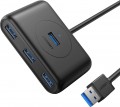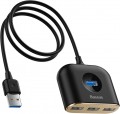This paragraph refers to the USB connector interface. The main difference between the interface versions is speed. It is worth noting that the speed of the input connector does not yet indicate the overall throughput, since the simultaneous connection of
flash drives,
phones, memory cards slows down data transfer, which anyway is limited by the interface for connecting the device itself to a PC or
laptop(item "Connection interface").
- USB 2.0. The outdated version 2.0 provides data transfer rates up to 480 Mbps. Found only in USB A ports.
- USB 3.2 gen1. The previous names of the USB 3.1 gen1 and USB 3.0 standard (they know how to confuse). This version provides 10 times the maximum speed (4.8Gbps) as well as higher power supply, which allows you to connect power-hungry devices and large splitters.
- USB 3.2 gen2. Further improvement of the USB 3.2 gen1 standard (and, as is customary, the previous name USB 3.1 gen1 and simply USB 3.1, which was renamed more than once), made it possible to achieve a maximum speed of 10 Gbps and even higher power for external devices.
The main material used for the body of the device.
— Plastic. Plastic is light, cheap, quite practical, incl. has good strength properties. In addition, it allows you to create cases of complex shape and almost any color.
—
Metal. As a rule, aluminium-based alloys are used for metal cases. Such cases are much stronger than plastic ones, and also have a stylish appearance. On the other hand, in terms of impact protection, this material has no advantages over plastic, but it costs more, and it can weigh much more.

